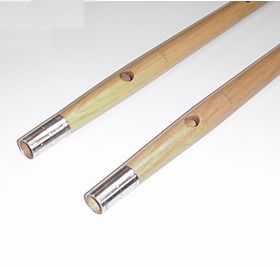|
South American, Boxwood (gossypiopermum praecox.)
|

Click on a picture to enlarge
|
Other names for this wood are Maraciabo boxwood, Agracejo, Palo Blanco,
Cuchillo, Limoncillo, Manzano, Sapatero, and Zapatero. These are names used
in the local areas where the wood in located, West Indies, Columbia and
Venezuela. Grain straight and uniform, fine texture, carves and turns
easily, cream or pale yellow in color. White to lemon colored hardwood with
straight grain and fine uniform texture. A great substitute for English
boxwood
The boxwood used by 18th century makers was either English, European, or the
closely-related Turkish boxwood, prized for its hardness, tonal quality, and
resistance to water. This wood is only occasionally used today, not just
because of its rarity and high cost but also because it often has knot holes
and tends to warp very easily as it ages. Most instruments from European
makers labeled as boxwood are in fact made from a South American wood known
variously as Maracaibo, Zapatero, or Venezuelan boxwood, which is plentiful,
easy to work, highly stable, but softer in tonal properties than true
European boxwood. South American boxwood is intermediate in cost and tonal
quality between the softer European domestic fruitwoods and maple on one
hand and the denser exotic tropical hardwoods on the other; it has a clear,
cool, neutral sound equally suited to solo or ensemble playing.
|
Copyright 2003-2017, Peeler Fife Company, All Rights Reserved.
For problems with web functions (broken links, missing pages, etc.) contact
webmaster@peelerfifes.com
|
|